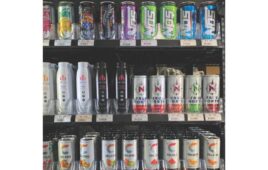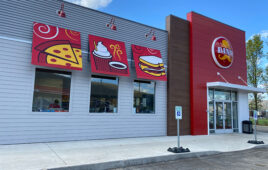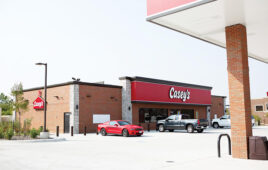Get the basics down pat—whether coffee and bakery, roller grill or sandwiches—to build a strong food menu foundation.
By Marilyn Odesser-Torpey, Associate Editor
The first foodservice offering at Ashland, Ky.-based Clark’s Pump ‘n Shop were prepackaged sandwiches and a microwave to heat them. After that came roller grills with hot dogs and tornados.
Then, in 2009, the company took a big leap into the category by introducing Krispy Krunchy Chicken into some of its stores. The first hot cases were three feet long.
While most of the stores now have five-foot hot cases, in its new store in Olive Hill, Ky., Clark’s had to install an eight-foot-long hot case and eight-foot-long deli case to accommodate all the food items on the store’s menus. Of the company’s 68 stores in Kentucky, Florida, Ohio and West Virginia, 22 feature grab-and-go hot and cold sandwiches and 20 have the full-service Clark’s Café concept which emphasizes made-to-order options.
“As we grew our foodservice and got our feet wet we learned about the hurdles we would have to overcome,” said Brian Unrue, Clark’s director of operations. “Profit margins, labor and packaging costs can kill you.”
For its ledgers, Clark’s divides its foodservice program into two categories, “Deli,” which is sliced meats, cheeses and salads sold by the pound, and “Fast Food,” which encompasses all the prepared items. To keep track of what’s selling, the company conducts five audits every month, one every Wednesday and one at the end of the month.
Chicken—which Unrue emphasizes is fresh, never frozen—is a big seller in the stores, particularly boneless tenders. Seven stores feature Krispy Krunchy Chicken, while 12 others serve Clark’s own proprietary recipe.
To differentiate its chicken from quick-serve restaurant competitors, Clark’s uses a larger four-ounce tender in its proprietary program.
“Everything is carefully portioned to control cost of goods for us and provide value to our customers,” Unrue said.
Stores have a core menu but can include other items that suit their customers’ purchasing preferences.
“We sell the heck out of veal cutlet at our McArthur, Ohio store, but can’t even give it away anywhere else,” Unrue said.
Breakfast platters with egg, biscuits and gravy, sausage or bacon are available in the cafe stores. Customers can also go down a hot line, a la Subway, to build their own breakfast sandwich.
Some of the stores have other build-your-own options for deli sandwiches, grilled cheese and tacos, burritos, bowls and quesadillas.
Appetizers are becoming increasingly popular with and between meals, Unrue said.
“We’re selling a lot of cheese sticks, fried pickles, jalapeño poppers and potato wedges, so we keep them in the hot case all day long,” said Unrue.
With food sales going strong, all seven of the Pump ‘n Shop stores opened over the past nine months have a Clark’s Café with full kitchen that serves breakfast, lunch and dinner. As far as kitchen size, Unrue used to think less was more.
“We only allotted around 56 square feet for our original kitchens,” said Unrue. “I wish I had known before that consumers would trust us to provide a variety of high-quality foods so we would have made our kitchens bigger.”
Kitchens in newer stores average 250 to 400 square feet and have deep fryers, griddles, convection ovens with stovetops and double-door coolers instead of the smaller walk-ins that were previously used. Food has become such a big category at Pump ‘n Shop that the Olive Hill store provides seating for 40 guests.
Unrue noted that the company is getting ready to test a customer ordering kiosk in one of its stores.
“I see multiple benefits to that,” said Unrue. “From a labor standpoint, there will be no more downtime waiting for customers to make up their minds what they want. Because the order goes directly into the kitchen, it will save on mistakes in order preparation and enhance speed of service. It will also track what customers add on like tomatoes and onions, which will help with food costs.”
All food items, including the sandwich add-ons, are assigned price look-up codes (PLUs) and the stores’ point-of-sale (POS) system tracks those sales making identifying, pulling and replacing non-performing products easier. To provide more options for replacement, quarterly limited time offers (LTOs) are offered. Those that track well, like a recent “potato keg” (a cheese-filled potato tot) may be retained on the menu while “losers get lost,” Unrue said.
TRIAL AND ERROR
Thirty years ago, Nittany Oil MiniMart, which has 26 stores in Pennsylvania, launched its foodservice program with made-in-house hoagies, hot dogs and a few fryer items. Since then, the chain has evolved its menu to offer fresh-dough pizza, a wider variety of fryer selections and wraps inspired by customers looking for “better-for-you” alternatives to regular sandwiches.
“A lot of what we did to discover what our customers’ wanted was trial and error over the years,” said Angela Gearhart, MiniMart’s food service category manager.
Much of that trial and error adding to and tweaking the menu was done on a store-by-store basis.
“In our stores where we get a lot of road and construction workers, we learned they want grab-and-go hot and cold sandwiches and snack cups so they can come in and get right back out,” Gearhart said. “In other stores, we have customers who are willing to wait for made-to-order service.”
To keep up with what customers crave, suggestions from store foodservice managers are sought. Many times, they inspire LTOs that are changed up every two months.
BOLSTER THE BASICS
With numerous store acquisitions under its belt and more to come, Des Moines, Iowa-based Yesway Convenience Stores is juggling a lot of balls when it comes to foodservice. The company currently operates 150 stores spanning nine states.
“Within our portfolio are a lot of opportunities and platforms including made to order and hot and cold grab and go,” said Jeff Keune, senior vice president of food service and innovation. “We take a lot of time elevating quality, taste and excitement around our platforms.”
One of the first things Yesway does after acquiring a new store is to invest in strengthening the basics, he said. That includes installing roller grills if the store doesn’t already have them. The coffee and fountain programs are also enhanced to use filtered water, Yesway’s own branded coffee and the right ice; selecting the most popular beverage flavor profiles and providing the right cups.
Even hot dogs are a big deal at Yesway.
“You have to get it right,” said Keune. “We want guests to say ‘Wow. Have you had a hot dog from Yesway?’”
Acquisition of stores has allowed management at Yesway to “stretch ourselves and our brains” by identifying products and concepts to make the company’s foodservice broader and more differentiated. He pointed to one of its stores in Spearfish, S.D. that has “a fantastic breakfast burrito” via its drive-through window along with an espresso bar and “a wonderful cinnamon roll.”
“One of the best things about acquisitions is that we can find great products and programs to incorporate into our other stores,” Keune said.
Through acquisitions, Yesway has become the second largest franchisee of Orion Food Systems, with 20 of Orion’s concepts in its stores. These concepts are Orion’s Hot Stuff Pizza, Chix Chicken and Chopz sandwiches and salads.
“We make the most of partnership opportunities,” said Keune. “Borrowed equity is fine with the right partner.
At the same time, a chef-led team on Yesway’s staff is working to develop elevated pizza and fresh bakery offerings. “Our goal is a balance of branded and proprietary platforms,” he explained.
Ideas for foodservice expansion also come from other sources within the Yesway system including store general managers and customers. “I’m out in the stores every week and I listen a lot,” Keune said.
First Things First
Before embarking on any level of fresh foodservice, retailers have a lot of homework to do, said New York-based restaurant, retail and hospitality consultant Arlene Spiegel.
“Find out the board of health rules, what food-handling certifications are required for your state or states and insure the proper equipment is in place for merchandising and food safety,” said Spiegel.
Every municipality has public records regarding the demographic makeup of each trade area so it’s easy to find the number of homeowners vs. renters, ethnic and religious ratios and economic status. But, she noted, that information is only part of the picture that will guide operators to the food concepts and items they should offer.
“The deep dive into the communities’ lifestyle drivers and what they value is just as important,” she added.
Spiegel recommended that retailers look around at competing fast-casual and quick-service restaurant concepts and see where the parking lots are full.
That’s your competition and what your customers want,” she pointed out. “The store’s location in relation to the drive-by times—going or coming home from work or school—will also be a factor.”
Spiegel also suggested that retailers consider partnering with other food producers such as local bakeries and caterers to support their local communities and increase the breadth of products in their stores.




